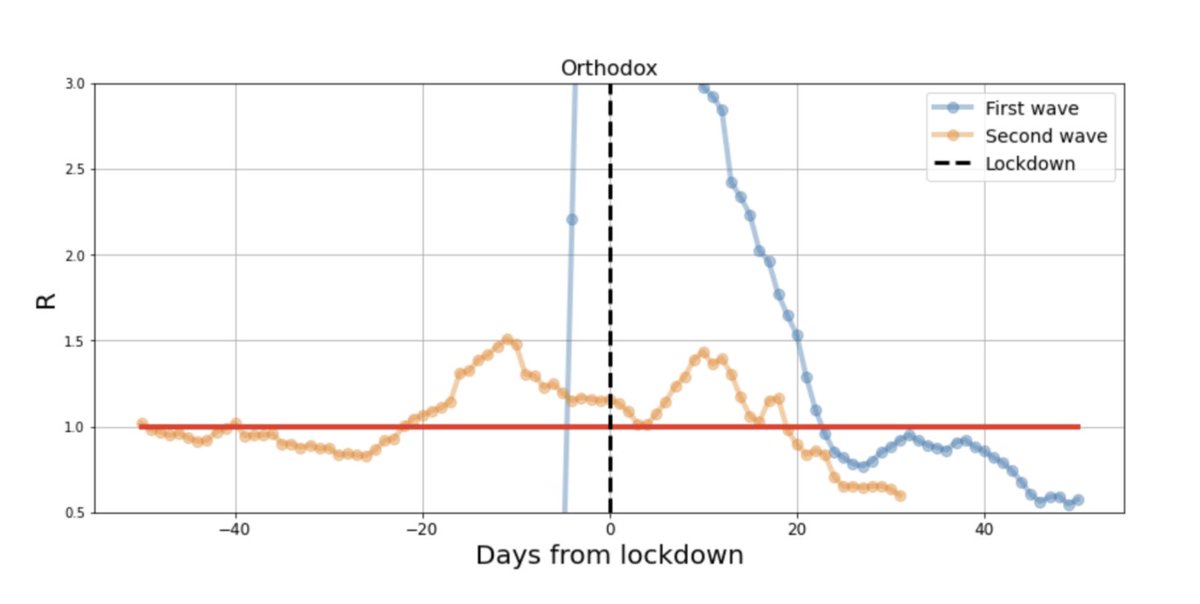Second lockdown?
In Israel, the first to impose a 2nd lockdown:
1. Surprisingly, the 2nd lockdown worked faster and more effectively than the 1st, despite being less tight
2. The effect differed across subpopulations, suggesting that differential policies may be effective
In Israel, the first to impose a 2nd lockdown:
1. Surprisingly, the 2nd lockdown worked faster and more effectively than the 1st, despite being less tight
2. The effect differed across subpopulations, suggesting that differential policies may be effective
Lockdown is always indicative of failure to manage the pandemic
In Israel, managing the pandemic based on the capacity of the healthcare system was the one major mistake from which all else followed
Define a capacity and you will reach it, at record levels and high death toll
In Israel, managing the pandemic based on the capacity of the healthcare system was the one major mistake from which all else followed
Define a capacity and you will reach it, at record levels and high death toll
I summarised the mistakes, and what happened in the second wave here: https://twitter.com/segal_eran/status/1313831721981415428?s=20">https://twitter.com/segal_era...
When the 2nd lockdown was imposed, many were skeptical, because it was less tight to begin with, and because people followed the guidelines less closely than the 1st
But it worked. In fact, the surprise was that it worked faster and cases dropped quicker than the 1st lockdown
But it worked. In fact, the surprise was that it worked faster and cases dropped quicker than the 1st lockdown
Cases dropped 10 days after the 2nd lockdown, compared to 20 days that it took for cases to drop after the 1st lockdown
R0, the average number that each person infects, also dropped to lower levels in the 2nd lockdown
R0, the average number that each person infects, also dropped to lower levels in the 2nd lockdown
A major surprise. What explains this? We don& #39;t really know, but maybe:
1. Masks, which are only now part of the guidelines
2. Closing activities with high spreading potential, mostly schools and gatherings of all types. This was common in both lockdowns
1. Masks, which are only now part of the guidelines
2. Closing activities with high spreading potential, mostly schools and gatherings of all types. This was common in both lockdowns
3. Other activities that were open in the 2nd lockdown but not the 1st (e.g., workplaces without customers) probably matter less and perhaps do not even need to be part of a lockdown
The second lockdown crushed all curves: cases, mild hospitalisations, moderate+severe, and severe ones
R0 of cases was 0.65 (a 50% drop in cases every week), and R0 of hospitalisations was 0.8 (a 50% drop every two weeks)
R0 of cases was 0.65 (a 50% drop in cases every week), and R0 of hospitalisations was 0.8 (a 50% drop every two weeks)
At this rate we expect to reach 200 daily cases within 3 weeks, though since we started to release the lockdown this rapid drop is unlikely to continue
This is all at the country level. But Israel has Orthodox, Arabs, and all others
Each had very different curves, suggesting that the pandemic does not necessarily behave the same across the country, and that differential policies across sectors may be effectively employed
Each had very different curves, suggesting that the pandemic does not necessarily behave the same across the country, and that differential policies across sectors may be effectively employed
In the orthodox, there were nearly no cases prior to the 1st lockdown, the rise only started afterwards, and it took 20 days for the lockdown to kick in
Before the 2nd lockdown there were many cases, it took 19 days for the lockdown to kick in, and the drop was sharper
Before the 2nd lockdown there were many cases, it took 19 days for the lockdown to kick in, and the drop was sharper
The general population was over 80% of cases on the eve of the 1st lockdown, and it took 17 days until cases started dropping
The 2nd lockdown lowered cases within 10 days and at a similar, perhaps even faster rate of drop in cases compared to the 1st
The 2nd lockdown lowered cases within 10 days and at a similar, perhaps even faster rate of drop in cases compared to the 1st
Finally, the curve of the Arab population was unrelated to both lockdowns
On the eve of the 1st, there were nearly no cases and even afterwards very few
On the eve of the 2nd lockdown, there were many cases but the drop started a few days before the lockdown
On the eve of the 1st, there were nearly no cases and even afterwards very few
On the eve of the 2nd lockdown, there were many cases but the drop started a few days before the lockdown
So at least in Israel, lockdowns work, and second lockdowns work even better
But Israel went to a lockdown because it had no choice: hospitalisations reached the capacity of the healthcare system. And that& #39;s a failure
But Israel went to a lockdown because it had no choice: hospitalisations reached the capacity of the healthcare system. And that& #39;s a failure
Many lessons to learn, mainly that we need to act fast, and that differential policies may work, if you can implement them

 Read on Twitter
Read on Twitter
















